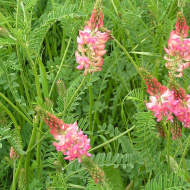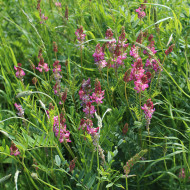All about the cultivation and use of the medicinal herb sainfoin
Content
Description of the plant and its distribution area
Depending on the species, the plant height is 30-80 cm, rarely 1 m or more. Sainfoin is distinguished from other productive herbs by a long taproot with strong branching in the upper part. The external description of all representatives of the genus is similar - usually it is a herbaceous shrub with pubescent or spiked stems. The leaf plates are complex - each one consists of a couple of dozen small elongated leaves attached to the petiole.
The perennial blooms with large spike-shaped inflorescences of different shades: white, cream, pinkish, lilac. Flowering begins only in the second year in June-July. Flowers open sequentially, but live no more than a day. The entire brush fades in 7-10 days. After that, the fruits ripen - wrinkled beans of gray-green color, similar to beans.

In the natural environment, the plant prefers dry calcareous soils, it is found on mountain slopes, forest edges, in meadows, along roads and river banks. The distribution area is mainly the central and southern parts of Europe, as well as Siberia. Certain species grow in Spain, Portugal, Tunisia, in the north of the African continent, Australia and North America.
Chemical composition
The culture has a fairly rich chemical composition, which allows it to be used for animal feed and for medicinal purposes. The terrestrial part of the plant contains a lot of vitamin C, carotene, fiber, carbohydrates, fatty oils, enzymes, phenolic compounds that protect the body from external negative influences.
The nutritional value of grass and beans consists of several types of protein. Of the micro- and macroelements, there are phosphorus, potassium, magnesium, calcium, iron, copper, zinc, as well as vitamins E, D, five B vitamins.
Useful and medicinal properties
Herbal remedies used in medicine have the following therapeutic effect:
- reduce blood sugar and cholesterol levels;
- increase immunity and contribute to the recovery of the body after physical overload, illness, injury;
- improve concentration and mental performance in general;
- increase the level of hemoglobin;
- normalize the work of the nervous system;
- increase libido;
- are used in the complex therapy of such female pathologies as ovarian dysfunction, cycle disorders, help asymptomatically survive menopause;
- help men to get rid of impotence and reduce the likelihood of prostate diseases.

Honey obtained from the flowers of the plant has high healing properties. It is very aromatic, with a rich taste, useful for colds and for a weakened body.
Harm and contraindications for use
There are no strict contraindications to the use of the herb for medicinal purposes, but there are people who may have an intolerance to the product. This is especially true of honey - in rare cases, an allergy may occur to it. When using drugs and decoctions for a long time, an increase in blood pressure and testosterone production is possible.
Video "Description of the herb sainfoin"
This video explains the health benefits of the herb.
Varieties of sainfoin
In nature, there are about 80 plant species growing on different continents. Many of them are endemic, such as the Siberian species, which is widespread in the western and eastern parts of this region, or Pallas, which is found on the Crimean Peninsula. In central and southern Europe, there are a couple of dozen species, but the following varieties are important for agriculture:
- Sowing. A two-year low culture (0.2-0.7 m) with a well-developed root system, from which many stems and branches grow. In private lands, it is grown most often, since it surpasses other species in green mass.
- Sandy. A powerful shrub grows in the steppes, on the slopes, prefers sandy soil. The stems are practically naked, without thorns, which makes it possible to use the grass for forage. It blooms with large (18-20 cm) inflorescences of white or pinkish color.
- Vicolytic. Bulky shrub about 90 cm high with erect, moderately hairy or bare stems. Blooms in June in large inflorescences of bright pinkish color. Occurs on the outskirts of fields and roads, in meadows.
- Sowing
- Sandy
- Vicolystny
Sowing and growing a medicinal plant
In many private farms, the grass is grown as a green manure or melliferous crop, as well as to feed livestock and horses. It is sown in spring, in March-April, as soon as the soil warms up to + 7 ... 10 ° C, or in autumn, at the end of September. As a green manure, it is sown on unstable clayey soils with high density. The powerful rhizome of the plant will loosen the soil and enrich it with nitrogen, making it suitable for more demanding crops.
The plot for sowing is prepared in advance. If the soil is acidic, it is lime. You need to sow not deeply, by 3-4 cm, otherwise you can not wait for seedlings. Since plants are often affected by various ailments and pests, it is recommended to sprinkle the seeds with ash before sowing. The best grass precursors are beets, potatoes, and corn.
Collection and procurement of raw materials
They start mowing grass for hay a week earlier than alfalfa, somewhere in early June, but the time is different in different regions. It is important to have time to mow before the buds are laid, since during this period the beneficial substances in the plant are contained in maximum concentration. During the season, the grass is mowed 2 times. To make it grow quickly, the cut is performed at a height of 7-8 cm.
For treatment, the leaves, roots and inflorescences of the plant are harvested. The collection of the ground part is carried out during the flowering period, the roots - with the onset of autumn. Raw materials are dried in the shade under a canopy, or in a dark, well-ventilated room. The roots are washed and cut into pieces before drying.
The use of sainfoin
For medicinal purposes, herbal decoctions are used, which are prepared according to a special recipe, depending on the diagnosis:
- To reduce sugar and strengthen the body: 1 tbsp. pour a spoonful of dry raw materials with 300 ml of boiling water, insist for 4 hours in a thermos, filter and take half a glass before meals.
- For female diseases: pour 1 tbsp with a glass of boiling water (200 ml). a spoonful of herbs, insist 6 hours to get a concentrated composition, drink 1 tbsp. spoon before meals up to 4 times / day.
- In the treatment of impotence: pour a spoonful of dry grass with a glass of boiling water, simmer on fire for 10 minutes, cool, drink 0.5 glass before bedtime for 1 month.
As you can see, sainfoin is a very useful crop, especially in private lands. Its cultivation does not require much effort and money, and the benefits are invaluable both for health and for the economy.

